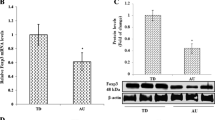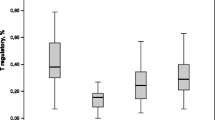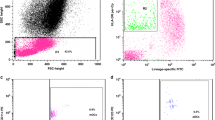Abstract
The aim of our study was to evaluate the frequencies of myeloid dendritic cells (mDCs) and plasmacytoid dendritic cells (pDCs) in children with ASD. Subjects were 32 children with ASD and 30 healthy children as controls. The numbers of mDCs and pDCs and the expression of CD86 and CD80 on the entire DCs were detected by flow cytometry. ASD children had significantly higher percentages of mDCs and pDCs when compared to controls. We found significant inverse relationships between serum 25-hydroxyvitamin D levels and the frequencies of mDCs and pDCs in autistic children. Our data suggested that DCs could play a role in the clinical course of ASD. The relationship of DCs to immune disorders in ASD remains to be determined.

Similar content being viewed by others
Abbreviations
- 25 (OH)D:
-
25-hydroxycholecalciferol
- ABC:
-
Aberrant behavior checklist
- ASD:
-
Autism spectrum disorder
- CARS:
-
Childhood autism rating scale
- DCs:
-
Dendritic cells
- mDCs:
-
Myeloid dendritic cells
- pDCs:
-
Plasmacytoid dendritic cells
References
Aman, M. G., Singh, N. N., Stewart, A. W., & Field, C. J. (1985). The aberrant behavior checklist: A behavior rating scale for the assessment of treatment effects. American Journal of Mental Deficiency, 89(5), 485–491.
American Psychiatric Association (2013). Diagnostic and statistical manual of mental disorders 5. Washington, DC: American Psychiatric Association.
Banchereau, J., Briere, F., & Caux, C. (2000). Immunobiology of dendritic cells. Annual Review of Immunology, 18, 767–811.
Bjørklund, G., Saad, K., Chirumbolo, S., Kern, J. K., Geier, D. A., Geier M. R. et al. (2016). Immune dysfunction and neuroinflammation in autism spectrum disorder. Acta Neurobiologiae Experimentalis (Wars), 76(4), 257–268.
Breece, E., Paciotti, B., Nordahl, C. W., Ozonoff, S., Van de Water, J. A., Rogers, S. J., et al. (2013). Myeloid dendritic cells frequencies are increased in children with autism spectrum disorder and associated with amygdala volume and repetitive behaviors. Brain, Behavior, and Immunity, 31, 69–75.
Cannell, J. J., & Grant, W. B. (2013). What is the role of vitamin D in autism? Dermatoendocrinology, 5(1), 199–204.
Careaga M, Ashwood P. Autism spectrum disorders: From immunity to behavior. In: Yan Q (ed) Psychoneuroimmunology methods and protocols. New York: Humana Press, pp 219–240.
Eyles, D. W., Burne, T. H., McGrath, J. J., & Vitamin, D. (2013). effects on brain development, adult brain function and the links between low levels of vitamin D and neuropsychiatric disease. Frontiers in Neuroendocrinology, 34, 47–64.
Ferreira, G. B., Gysemans, C. A., Demengeot, J., da Cunha, J. P., Vanherwegen, A. S., Overbergh, L., et al. (2014). 1,25-Dihydroxyvitamin D3 promotes tolerogenic dendritic cells with functional migratory properties in NOD mice. Journal of immunology (Baltimore, Md.: 1950), 1, 192.
Ferreira, G. B., Vanherwegen, A. S., Eelen, G., Gutiérrez, A. C., Van Lommel, L., Marchal, K., et al. (2015). Vitamin D3 induces tolerance in human dendritic cells by activation of intracellular metabolic pathways. Cell Reports, S2211–1247(15), 711–725.
Geier, D. A., Kern, J. K., & Geier, M. R. (2013). A comparison of the autism treatment evaluation checklist (ATEC) and the childhood autism rating scale (CARS) for the quantitative evaluation of autism. Journal of Mental Health Research in Intellectual Disabilities, 6(4), 255–267.
Gurney, J. G., McPheeters, M. L., & Davis, M. M. (2006). Parental report of health conditions and health care use among children with and without autism: National Survey of Children’s Health. Archives of Pediatrics and Adolescent Medicine, 160, 825–830.
Kern, J. K., Geier, D. A., Sykes, L. K., Homme, K. G., & Geier, M. R. (2014). Medical conditions in autism and events associated with initial onset of autism. OA. Autism: The International Journal of Research and Practice, 2(1), 9.
Mead, J., & Ashwood, P. (2015). Evidence supporting an altered immune response in ASD. Immunology Letters, 163(1), 49–55.
Ruggeri, B., Sarkans, U., Schumann, G., & Persico, A. M. (2014). Biomarkers in autism spectrum disorder: the old and the new. Psychopharmacology, 231(6), 1201–1216.
Saad K, Abdel-Rahman AA, Elserogy YM, Al-Atram AA, Cannell JJ, Bjørklund G et al. (2016a) Vitamin D status in autism spectrum disorders and the efficacy of vitamin D supplementation in autistic children. Nutrition Neuroscience, 19(8):346–351.
Saad K, Abdel-rahman AA, Elserogy Y, Al-Atram AA, El-Houfey AA, Othman HA et al. (2016b). Randomized-controlled trial of vitamin d supplementation in children with autism spectrum disorder. Journal of Child Psychology and Psychiatry. doi:10.1111/jcpp.12652.
Sakamoto, A., Moriuchi, H., Matsuzaki, J., Motoyama, K., & Moriuchi, M. (2015). Retrospective diagnosis of congenital cytomegalovirus infection in children with autism spectrum disorder but no other major neurologic deficit. Brain and Development, 37, 200–205.
Schieve, L. A., Gonzalez, V., Boulet, S. L., Visser, S. N., Rice, C. E., Van Naarden Braun K, & Boyle, C. A. (2011). Concurrent medical conditions and health care use and needs among children with learning and behavioral developmental disabilities, National Health Interview Survey, 2006–2010. Research in Developmental Disabilities, 33, 467–476.
Schopler E, Van Bourgondien M E, Wellman GJ. (2010) Childhood autism rating scale. 2nd. CARS-2. Los Angeles, CA: Western Psychological Services.
Steinman, R. M., Lasker Basic Medical Research Award (2007). Dendritic cells: versatile controllers of the immune system. Natural Medicines, 13(10), 1155–1159.
Ueno, H., Klechevsky, E., Morita, R., Aspord, C., Cao, T., Matsui, T., et al. (2007). Dendritic cell subsets in health and disease. Immunological Reviews, 219, 118–142.
van Halteren, A. G., van Etten, E., de Jong, E. C., Bouillon, R., Roep, B. O., & Mathieu, C. (2002). Redirection of human autoreactive T-cells Upon interaction with dendritic cells modulated by TX527, an analog of 1,25 dihydroxyvitamin D (3). Diabetes, 51(7), 2119–2125.
Voineagu, I., Wang, X., Johnston, P., Lowe, J. K., Tian, Y., Horvath, S., et al. (2011). Transcriptomic analysis of autistic brain reveals convergent molecular pathology. Nature, 474, 380–384.
Wang, T. T., DU, L., Shan, L., & Jia, F. Y. (2014). Research advances in immunological dysfunction in children with autism spectrum disorders. Zhongguo Dang Dai Er Ke Za Zhi, 16(12), 1289–1293.
Wilson, E. H., Weninger, W., & Hunter, C. A. (2010). Trafficking of immune cells in the central nervous system. The Journal of Clinical Investigation, 120, 1368–1379.
Acknowledgments
The authors would like to extend their sincere appreciation to the Deanship of Scientific Research at king Saud University for its funding this Research group No. (RG-1435-019).
Author Contributions
KE, KS, AAA, MH, AA and YE designed the study, followed the patients, analyzed the data, and drafted the manuscript. AZ performed all laboratory investigations in the study. All authors were involved in the critical analysis of the final version of the manuscript. All authors approved the manuscript as submitted and agree to be accountable for all aspects of the work.
Author information
Authors and Affiliations
Corresponding author
Ethics declarations
Conflict of interest
All authors do not have potential conflict of interest.
Rights and permissions
About this article
Cite this article
Saad, K., Zahran, A.M., Elsayh, K.I. et al. Frequency of Dendritic Cells and Their Expression of Costimulatory Molecules in Children with Autism Spectrum Disorders. J Autism Dev Disord 47, 2671–2678 (2017). https://doi.org/10.1007/s10803-017-3190-5
Published:
Issue Date:
DOI: https://doi.org/10.1007/s10803-017-3190-5




